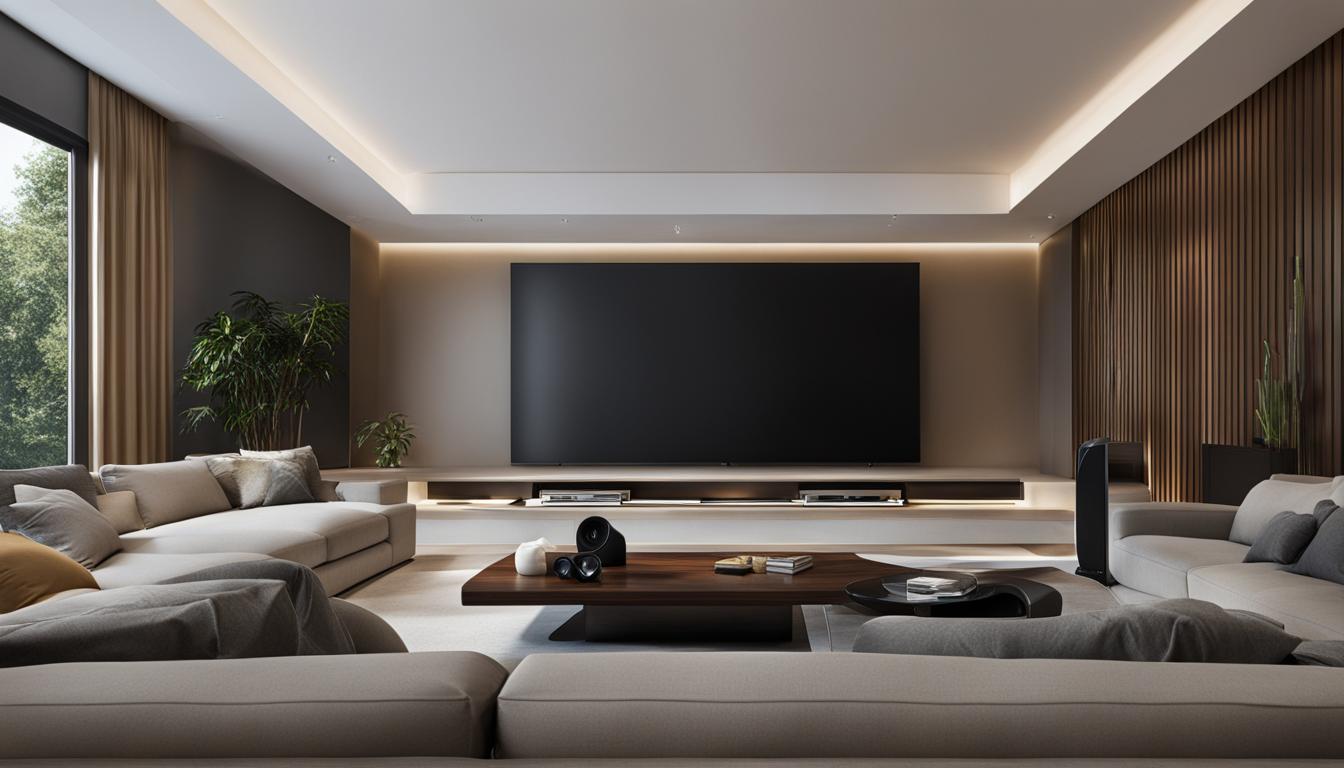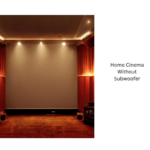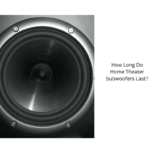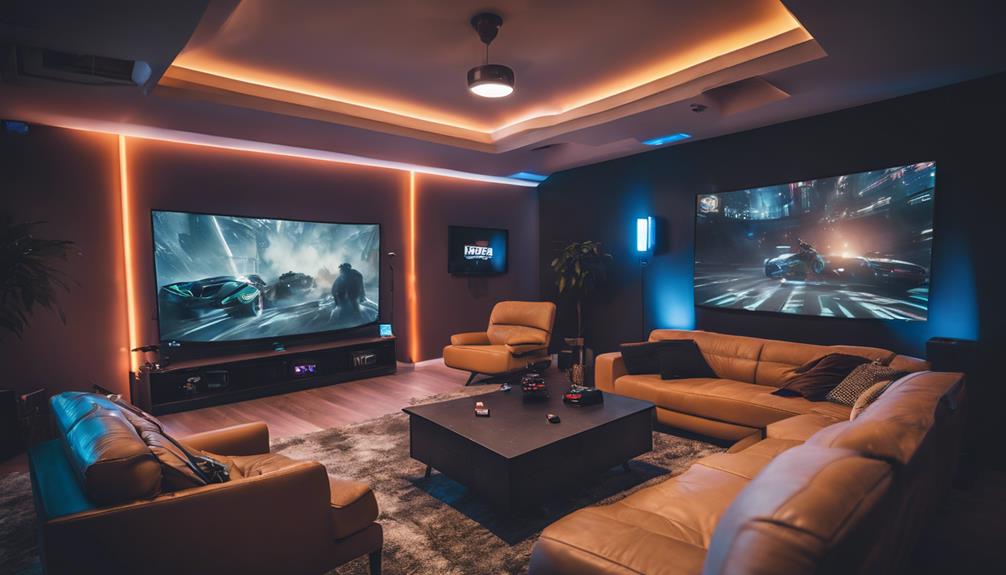Welcome to our comprehensive guide on home theater subwoofer placement. Finding the optimal placement for your subwoofer is crucial for achieving the best sound quality and enhancing your home theater experience. With factors such as available floor space, room layout, and decor considerations, it can be a challenging task to determine the ideal position for your subwoofer. In this guide, we will provide you with the information and techniques you need to master the placement of your home theater subwoofer.
Key Takeaways:
- Proper subwoofer placement is essential for balanced and accurate bass response.
- Consider front placement or corner placement to optimize bass performance.
- Use the subwoofer crawl technique to fine-tune the placement for optimal performance.
- Be flexible with your listening position and utilize EQ for improved bass response.
- Consider using bass traps or dual subwoofers for enhanced bass performance.
Importance of Subwoofer Placement
Proper subwoofer placement is crucial for achieving optimal sound quality in your home theater system. The positioning of your subwoofer determines how well it blends with the main speakers and delivers accurate bass response. By following the tips and techniques outlined in this section, you can enhance your audio experience and create an immersive surround sound environment.
One of the main benefits of proper subwoofer placement is the reduction of localization effects. When the subwoofer is positioned correctly, the bass seamlessly integrates with the sound coming from the main speakers, eliminating any sense of the bass coming from a separate source. This enhances the overall coherence of the audio and makes it more enjoyable to listen to.
Another reason why subwoofer placement is important is to minimize standing wave modes. These room resonances can create peaks and nulls in the bass response, resulting in uneven sound quality. By experimenting with different placement options and utilizing tools like the subwoofer crawl technique, you can find the sweet spot that minimizes the impact of these modes and delivers a smoother and more even bass response.
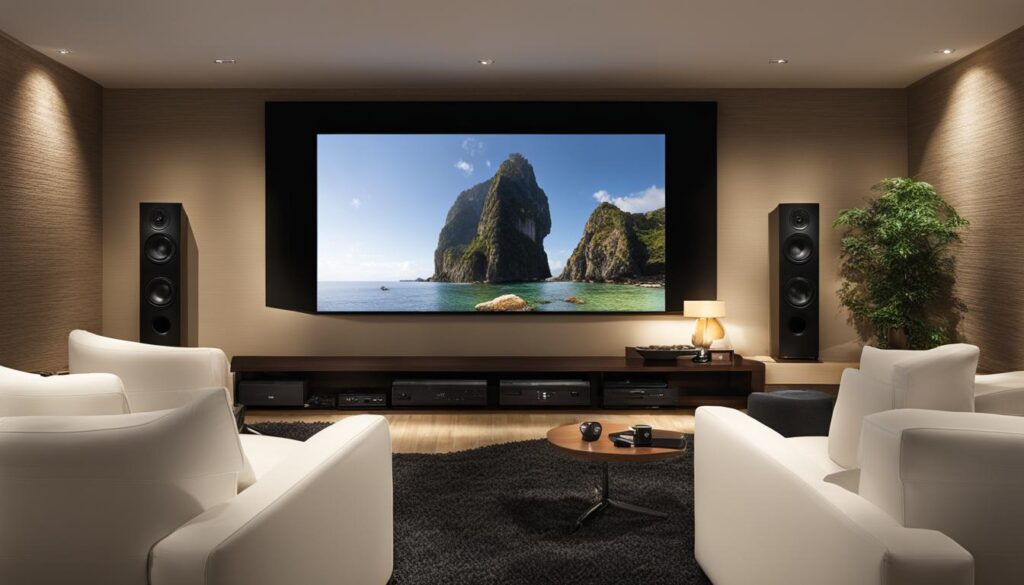
Table: Comparison of Different Subwoofer Placements
| Placement | Pros | Cons |
|---|---|---|
| Front Placement | Excellent blending with main speakers Minimized localization effects |
May limit seating arrangement options Bass response may vary depending on room dimensions |
| Corner Placement | Excites all room modes for denser standing wave pattern Can provide enhanced bass performance |
May result in boomy or overpowering bass Can be challenging to integrate with main speakers |
As shown in the table above, there are different pros and cons associated with each subwoofer placement option. It’s important to consider your specific room dimensions, seating arrangement, and personal preferences when deciding on the placement that works best for you.
By understanding the importance of subwoofer placement and experimenting with different options, you can achieve balanced and accurate bass response, enhance the overall sound quality of your home theater system, and create a cinematic audio experience right in the comfort of your own home.
One Spot or Multiple Locations?
When it comes to subwoofer placement in a home theater, one key decision you’ll need to make is whether to have your subwoofer in one spot or multiple locations. The choice between these options depends on the layout of your room and the level of flexibility you have in terms of positioning.
If you have limited space or if your home theater is set up in a living or family room, a single location for your subwoofer may be more practical. However, if you have a dedicated home theater room, you have the advantage of exploring different locations and listening positions.
By experimenting with different subwoofer placements, you can find the sweet spot that offers the best bass response and overall sound quality in your specific room. Whether it’s a single location or multiple locations, the goal is to achieve optimal performance and enhance your home theater experience.
Table: Pros and Cons of One Spot vs. Multiple Locations
| One Spot | Multiple Locations |
|---|---|
| Pros: | Pros: |
|
|
| Cons: | Cons: |
|
|
As you can see, both one-spot and multiple-location subwoofer placements have their advantages and disadvantages. Consider your room size, layout, and personal preferences when making a decision. Ultimately, the goal is to find the placement option that delivers the best bass performance and enhances your overall movie-watching and music-listening experience in your home theater.
Front Placement and Corner Placement
When it comes to subwoofer placement in a home theater, two popular options are front placement and corner placement. Each option offers its own advantages in terms of bass response and overall sound quality. Let’s take a closer look at both options and how they can enhance your home theater experience.
Front Placement
Placing your subwoofer in the front of the room, near the center channel and main speakers, is a common choice for many home theater setups. This placement allows the subwoofer to blend seamlessly with the rest of the audio system, resulting in a balanced and cohesive sound. Front placement also helps minimize localization effects, where you can identify the distinct location of the subwoofer, creating a more immersive audio experience.
Corner Placement
Corner placement is another popular option that can deliver optimal bass response in a home theater. By positioning the subwoofer in a corner, you excite all possible room modes and create a denser standing wave pattern. This can result in a more powerful and impactful bass reproduction. However, it’s important to note that corner placement may not be suitable for every room, as it can sometimes lead to an uneven frequency response. Experimentation and room acoustics considerations are key when deciding on corner placement.
Ultimately, the best subwoofer placement for your home theater will depend on the specific characteristics of your room and personal preferences. It’s a good idea to experiment with both front and corner placement options to find the position that delivers the optimal bass response and suits your listening environment. Don’t be afraid to try different locations and make adjustments along the way to achieve the best possible audio performance.
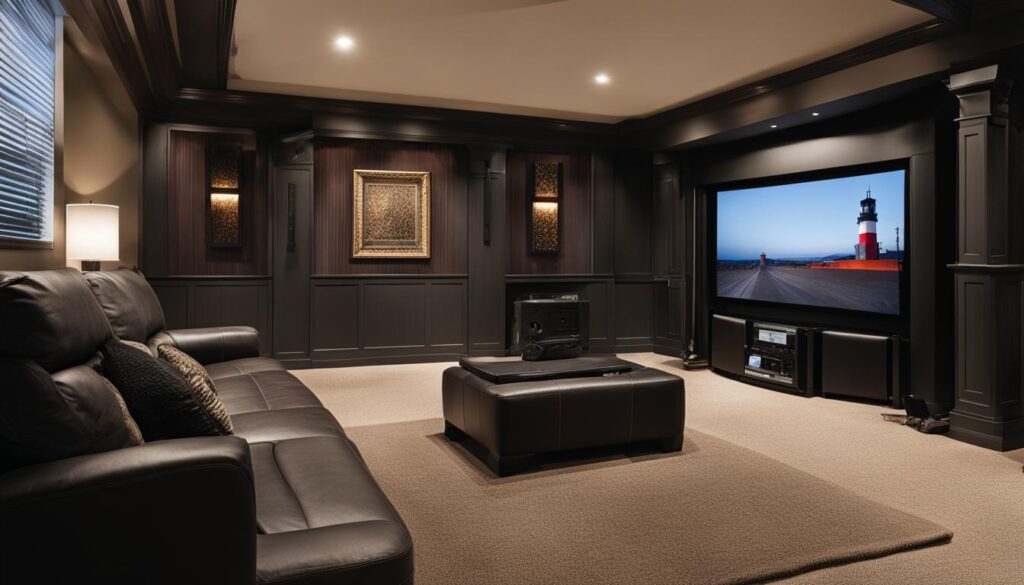
| Placement Option | Advantages |
|---|---|
| Front Placement | – Seamless blending with main speakers and center channel – Minimized localization effects – Balanced and cohesive sound |
| Corner Placement | – Optimal bass response – More powerful and impactful bass reproduction – Excites room modes and standing wave patterns |
Subwoofer Placement Tips and Tricks
If you have multiple placement options for your subwoofer and want to find the best sound possible, the “subwoofer crawl” technique can be a great tool. This technique involves placing the subwoofer at or near the main listening position and evaluating the bass quality at each available location in the room. By keeping your head at or near knee level while listening, you can determine the location that provides the most accurate and balanced sounding bass. It’s important to note that bass frequencies can be affected by the dimensions and characteristics of your room, so taking the time to try out different locations can make a significant difference in the overall performance of your subwoofer.
Being flexible with your listening position can also contribute to improved bass response. Small changes in the seating location can often yield significant benefits by moving out of peaks or nulls and into a more neutral sounding area. For example, if you notice a significant drop or increase in the bass at your usual listening position, try sitting slightly to the left or right, or even slightly forward or backward. These subtle adjustments can help you find the “sweet spot” where the bass response is balanced and accurate.
Bass Traps and Dual Subwoofers
If you have a dedicated listening room or home theater, you may consider using bass traps to improve bass response. Bass traps are acoustic panels or devices that help reduce the reflected bass energy in the room, minimizing the severity of modal peaks and nulls and improving overall sound quality. By strategically placing bass traps in corners or along walls, you can achieve a more controlled and balanced bass response.
Another option to enhance bass performance is to use dual subwoofers. Dual subwoofers provide a smoother frequency response at multiple listening positions and increase the effectiveness of any EQ applied to the system. By placing the subwoofers in different locations in the room, you can minimize the impact of room modes and achieve more accurate and impactful bass throughout the listening area.
| Tip | Description |
|---|---|
| Try different locations | Experiment with placing the subwoofer in different spots in the room to find the best bass response. |
| Use the subwoofer crawl technique | Place the subwoofer at or near the main listening position and evaluate the bass quality from different locations. |
| Be flexible with your listening position | Small changes in seating location can greatly impact bass response, so don’t be afraid to adjust your position to find the sweet spot. |
| Consider bass traps | Bass traps can help reduce room reflections and improve overall bass response. |
| Try dual subwoofers | Using two subwoofers can provide a more even bass response throughout the listening area. |
By following these subwoofer placement tips and tricks, you can optimize the performance of your home theater system and enjoy a more immersive audio experience. Remember to take the time to experiment and fine-tune the placement to find the best bass response for your specific room and listening preferences.
Flexibility and EQ
When it comes to subwoofer placement in a home theater, flexibility is key. Being open to adjusting your listening position can greatly impact the bass response in your room. Small changes in seating location can make a significant difference by moving out of peaks or nulls and finding a more neutral sounding area. By experimenting with different positions, you can find the sweet spot that delivers the best bass performance.
Another tool that can enhance your subwoofer placement is equalization, or EQ for short. EQ allows you to adjust the frequency response of your subwoofer to compensate for room acoustics and address any issues caused by standing wave modal peaks or “boomy spots.” Some AV receivers come equipped with auto-set-up routines that can EQ the subwoofer channel, while external subwoofer equalizer systems are also available on the market. Utilizing EQ can help you achieve a more balanced and accurate bass reproduction in your home theater.

Bass Traps and Dual Subwoofers
In order to further improve the bass performance in your home theater, there are two additional techniques you can consider: bass traps and dual subwoofers.
To start with, bass traps are specially designed acoustic panels or devices that help reduce the reflections of low-frequency sound waves in your room. By strategically placing bass traps in corners and other areas where bass energy tends to accumulate, you can minimize the negative effects of modal peaks and nulls. This results in a more balanced and accurate bass response, enhancing the overall sound quality of your home theater system.
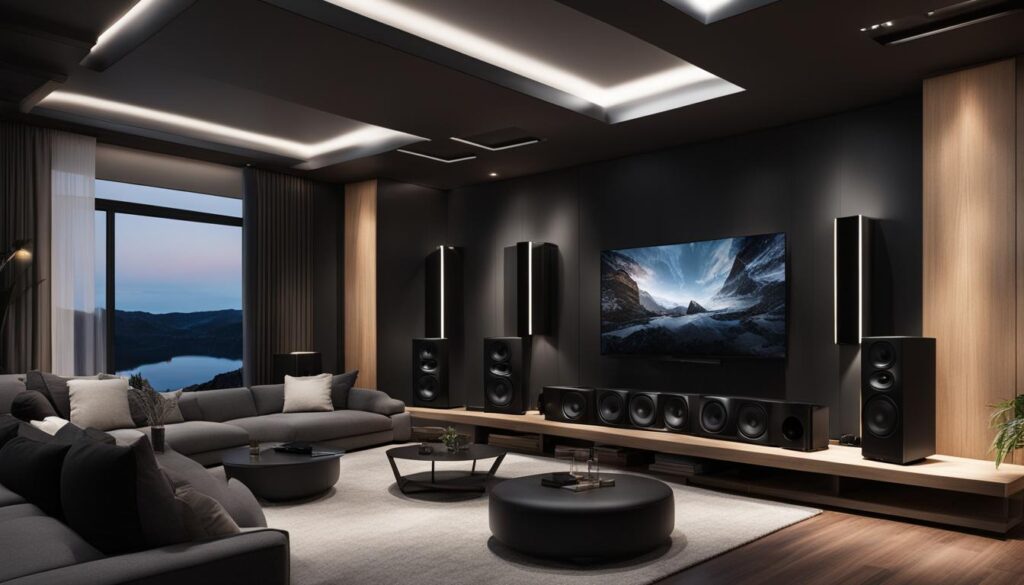
Another option is to use dual subwoofers. When properly positioned in the room, dual subwoofers can provide a more even bass distribution across multiple listening positions. This means that no matter where you are sitting in your home theater, you will enjoy consistent and powerful low-frequency performance. Additionally, dual subwoofers can help to mitigate room resonances and standing wave issues, resulting in smoother bass reproduction.
| Bass Traps | Dual Subwoofers |
|---|---|
| Minimize reflections and standing wave issues | Provide even bass distribution in multiple listening positions |
| Improve bass response and overall sound quality | Mitigate room resonances and standing wave issues |
| Enhance the immersive experience | Deliver consistent and powerful low-frequency performance |
Both bass traps and dual subwoofers can significantly enhance the bass performance of your home theater system. However, it is important to note that these techniques may require additional investment and proper calibration to achieve optimal results. Consider consulting with a professional or doing thorough research before implementing these advanced techniques in your home theater.
Bass Traps and Dual Subwoofers in Summary
- Bass traps minimize reflections and standing wave issues, improving bass response and overall sound quality.
- Dual subwoofers provide even bass distribution in multiple listening positions and help mitigate room resonances and standing wave issues.
- Both techniques enhance the immersive experience and deliver consistent and powerful low-frequency performance.
Importance of Subwoofer Selection
When it comes to creating an optimal home theater experience, selecting the right subwoofer is just as important as finding the perfect placement. The subwoofer is responsible for delivering deep, powerful bass that adds richness and impact to your audio. To ensure that your subwoofer performs at its best, there are a few key factors to consider.
- Size: The size of the subwoofer can greatly impact its performance. Larger subwoofers generally have more power and can produce deeper bass frequencies. However, it’s important to choose a size that is appropriate for your room and personal preferences.
- Output Level: The output level, often measured in terms of decibels (dB), determines how loud the subwoofer can get. Consider the size of your room and the listening distance to determine the appropriate output level for your needs.
- Design: Subwoofers come in various designs, including sealed, ported, and bandpass. Each design has its own characteristics and performance attributes, so it’s important to choose a design that suits your desired sound quality.
For the best bass response and integration with your home theater system, it is recommended to use identical subwoofers. This allows for optimal cancellation of room resonances and ensures a consistent listening experience. If using different subwoofers, make sure they have similar output levels and designs to avoid limiting the system’s dynamic range and bandwidth.
Investing in high-quality subwoofers that are capable of filling your room with ample bass without bottoming out is essential for achieving an immersive home theater experience. By selecting the right subwoofer for your needs and preferences, you can enhance the overall sound quality and make your movies, music, and games come alive.
| Factors to Consider | Size | Output Level | Design |
|---|---|---|---|
| Role | Determines the power and depth of bass | Determines how loud the subwoofer can get | Affects the characteristics and performance attributes |
| Considerations | Choose a size appropriate for your room and preferences | Consider the size of your room and listening distance | Choose a design that suits your desired sound quality |
Connecting Multiple Subwoofers
When setting up a home theater system with multiple subwoofers, it is important to ensure they are connected properly for optimal performance. The way you connect your subwoofers will depend on the outputs available on your AV receiver or processor.
If you have multiple subwoofer outputs, simply connect each subwoofer to a separate output using high-quality interconnects. This allows each subwoofer to receive its own dedicated signal, resulting in better bass distribution throughout the room.
However, if you only have one subwoofer output on your AV receiver or processor, you will need a Y-splitter to connect multiple subwoofers. A Y-splitter allows you to split the signal from the single output and send it to multiple subwoofers. It is important to use a quality Y-splitter and ensure that it is properly connected to avoid any signal loss or degradation.
Connecting Multiple Subwoofers – Step-by-Step Guide
- Check the available outputs on your AV receiver or processor. Identify whether you have multiple subwoofer outputs or just one.
- If you have multiple subwoofer outputs, connect each subwoofer to a separate output using high-quality interconnects.
- If you only have one subwoofer output, use a Y-splitter to split the signal and connect multiple subwoofers. Ensure the Y-splitter is properly connected and secure.
- Once the subwoofers are connected, calibrate and configure them according to the instructions provided with your AV receiver or processor. This may involve adjusting volume levels, crossover frequencies, and phase settings for each subwoofer.
- Perform a sound test to ensure each subwoofer is producing the desired bass response and blending well with the rest of your home theater system.
By connecting multiple subwoofers correctly, you can achieve a more even bass response and enhanced low-frequency performance in your home theater. Remember to use quality interconnects and follow the manufacturer’s instructions for setup and calibration. With the right connections and configurations, you can create a powerful and immersive audio experience.
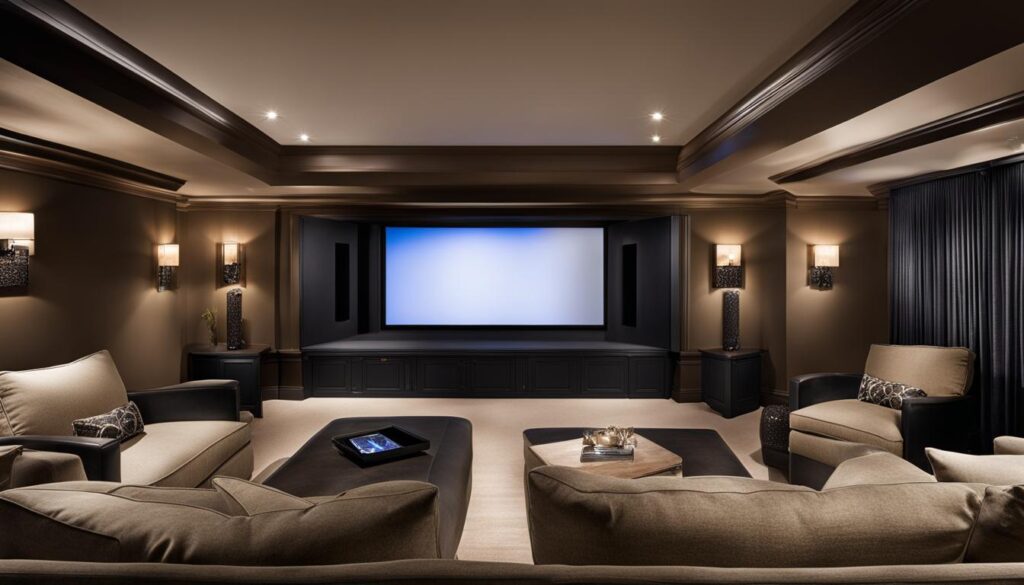
Note: The image above provides a visual representation of how to position a subwoofer in a home theater. The exact placement will depend on the specific room and setup.
Conclusion
In conclusion, achieving optimal subwoofer placement is crucial for enhancing your home theater experience. By following the tips and techniques outlined in this guide, you can ensure balanced and accurate bass response, improved sound quality, and an immersive audio experience.
Remember to experiment with different placement options and utilize tools such as the subwoofer crawl technique and EQ to fine-tune the placement for optimal performance. These methods will help you find the sweet spot that offers the best bass response and overall sound quality in your specific room.
It’s also important to choose high-quality subwoofers that can deliver the desired bass performance. Pay attention to factors such as size, output level, and design when selecting subwoofers for your home theater system. Additionally, properly connecting multiple subwoofers, if used, is crucial for achieving maximum benefits.
By putting in the effort to master your home theater subwoofer placement, you can create a truly immersive and high-fidelity audio experience that brings your movies, music, and games to life. So, go ahead and make the most of your home theater system by optimizing your subwoofer placement.
FAQ
What role does subwoofer placement play in the overall sound quality of a home theater system?
Proper subwoofer placement ensures balanced and accurate bass response, minimizes localization effects, and helps create an immersive surround sound experience.
Should I place my subwoofer in one spot or explore multiple locations?
Depending on your room layout and available space, both options can work. It is worth experimenting with different subwoofer placements to find the sweet spot that offers the best bass response and overall sound quality.
What are the benefits of front placement and corner placement for subwoofers?
Front placement results in excellent blending with the main speakers and minimizes localization effects. Corner placement excites all possible room modes and can provide a denser standing wave pattern, delivering optimal bass response. It is worth experimenting with both options to find the best placement for your specific room.
What is the subwoofer crawl technique?
The subwoofer crawl technique involves placing the subwoofer at or near the main listening position and evaluating the bass quality at each available location in the room. By listening with your head at or near knee level, you can determine the location that provides the most accurate and balanced sounding bass.
How does flexibility with listening position and equalization contribute to improved bass response?
Small changes in seating location can often yield significant benefits by moving out of peaks or nulls and into a more neutral sounding area. Equalization can be used to tame standing wave modal peaks or “boomy spots.” Some AV receivers have auto-set-up routines that can EQ the subwoofer channel, and external subwoofer equalizer systems are also available.
What are bass traps and how can they improve bass response?
Bass traps reduce reflected bass energy in the room, minimizing modal peaks and nulls and improving overall sound quality. Using dual subwoofers can provide a smoother frequency response at multiple listening positions and increase the effectiveness of any EQ applied to the system.
What factors should I consider when selecting subwoofers for my home theater system?
Size, output level, and design are important factors to consider. It is recommended to use identical subwoofers for optimal cancellation of room resonances. If that is not possible, select subs with similar output level and design to avoid limiting the system’s dynamic range and bandwidth.
How should I connect multiple subwoofers in a home theater system?
If your AV receiver or processor has multiple subwoofer outputs, simply connect each subwoofer to a separate output. If you only have one subwoofer output, you will need a Y-splitter to connect both subs. It is important to use quality interconnects that are well shielded and constructed for optimal performance.
What are the key takeaways for proper subwoofer placement?
Proper subwoofer placement is essential for maximizing performance. Experiment with different placement options, utilize tools like the subwoofer crawl technique and EQ, invest in high-quality subwoofers, and connect them properly for optimal integration into your system.
Source Links
- https://www.digitaltrends.com/home-theater/how-to-setup-a-subwoofer/
- https://www.audioholics.com/subwoofer-setup/subwoofer-connection-guide
- https://www.svsound.com/blogs/subwoofer-setup-and-tuning/75365187-the-art-of-subwoofer-placement
Hi, I’m Dominique. I love movies and want everyone to have the best home cinema experience possible. That’s why I started 1home Theatre Projector. We help people build their home cinema system using the latest technology and news on laser tv and all-around home entertainment.
We’re a small team of movie buffs (and experts) who are passionate about giving our readers the best advice and information possible. So whether you’re just starting out or you’re looking to upgrade your home cinema system, we’ve got you covered!
